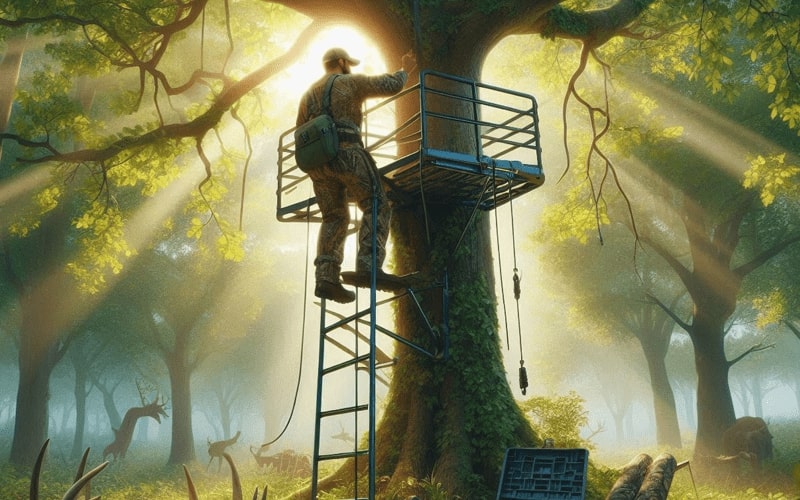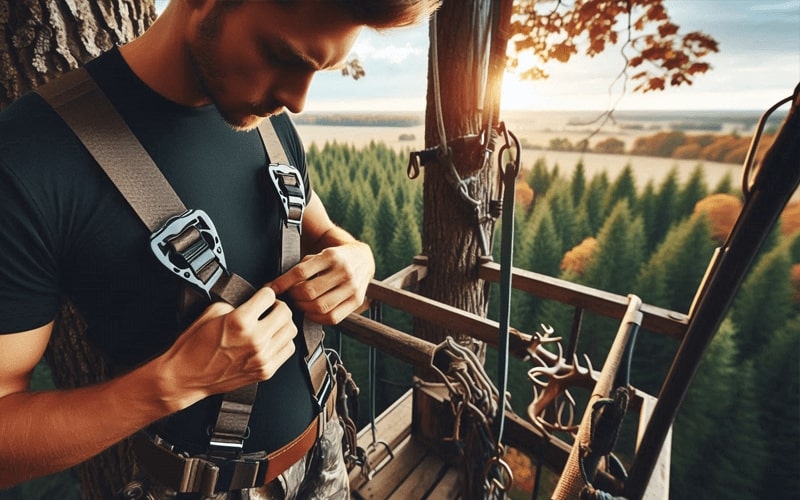Hunting deer from a treestand can really boost your chances of success because it gives you a better view and helps you stay hidden. But it’s important to keep in mind that using a treestand has its own risks. In fact, the National Bowhunter Education Foundation states that 1 in 3 hunting injuries happens because of treestand accidents. That’s why it’s super important to focus on safety while also having a good hunting strategy.

To make the most of your hunts and stay safe, you need to think about how you set up your treestand, where you position it, and how to blend in with your surroundings. In this guide, we’ll share some essential tips to help you stay safe and improve your skills, so you can avoid common mistakes and enjoy every hunting trip. Ready to up your treestand game?
Let’s get started!
12 Tips for Deer Hunting from a Treestand
Here’s a detailed breakdown of each tip for safe and successful deer hunting from a treestand, incorporating your insights and ensuring each point is informative:
1. Hang Treestands Early

The sooner you hang your treestands, the better your chances of success will be. Ideally, aim to set them up at least one to two months before the hunting season begins. This approach helps to avoid pressuring deer, allowing them to adapt to the new structure in their environment. By giving deer time to adjust, you increase your likelihood of encountering them during the actual hunting season.
2. Consider the Hang-and-Hunt Method
Sometimes, it’s beneficial to wait until the day of your hunt to hang a lock-on stand. This method, known as “hang-and-hunt,” prevents you from disturbing deer in the area beforehand. To execute this tactic effectively, you’ll need a lightweight, quiet lock-on stand along with a set of silent climbing sticks. This allows you to set up without alerting nearby deer, ensuring they remain unaware of your presence.
3. Optimal Height for Your Stand
Finding the right height for your treestand is crucial for both safety and effectiveness. Aim to hang your stand between 15 to 25 feet off the ground, with 20 feet being the sweet spot. This height not only provides a good vantage point for spotting deer but also improves your shot angle. Hanging too low may compromise your concealment, while hanging too high can reduce your kill zone, making it harder to take a successful shot.
4. Cut Shooting Lanes Wisely
When preparing shooting lanes, it’s essential to have a buddy system in place. One person should be in the stand to assess sightlines while the other trims branches. This method helps ensure you maintain optimal visibility without over-cutting, which could spook deer or reduce your cover. Be strategic about where you cut to keep your setup effective and minimize disturbance in the area.
5. Don’t Over-Cut
While it’s important to create clear shooting lanes, cutting too many branches can alert deer to your presence and remove critical cover. Only trim what’s necessary to allow for a clean shot. In some situations, leaving the natural foliage intact may be the best strategy, especially if you’re employing a hang-and-hunt style approach where you want to keep the area as undisturbed as possible.
6. Choose a Tree with Back Cover
Selecting the right tree is vital for staying concealed during your hunt. Look for a tree with a thick trunk and plenty of limbs to provide back cover. This setup prevents you from being skylined, which makes it easier for deer to spot you. A well-chosen tree enhances your camouflage and allows you to blend into the natural surroundings, increasing your chances of a successful hunt.
7. Enhance Your Cover
In addition to choosing a tree with good back cover, you can further improve your concealment by adding extra cover around your stand. Hanging additional limbs or branches especially from coniferous trees can help you blend in even more. These natural elements not only provide better camouflage but also help break up your outline against the sky, making it harder for deer to detect your presence.
8. Position Stands Wisely
When placing your treestand, consider the travel patterns of deer but avoid positioning it directly over trails. This strategic placement reduces the chances of deer detecting your scent and improves your odds of getting a clean shot. Instead, try to find a spot that allows you to remain hidden while still being close enough to where deer typically pass. This balance is key for successful bowhunting.
9. Stay Prepared for Quick Shots
Always keep your bow on a Realtree EZ Hanger and ensure all your gear is readily accessible. Deer often appear suddenly, giving you only a few seconds to prepare for a shot. Having your equipment organized and ready means you can swiftly grab your bow, draw it, and take aim in a timely manner. Being prepared for quick shots can make the difference between success and missed opportunities.
10. Compensate for Shot Angles
Understanding deer anatomy is crucial for making accurate shots. Familiarize yourself with where the vital organs are located and how different shot angles affect your aim. Knowing how to compensate for these angles will help ensure a quick, humane kill. It’s your responsibility as a hunter to pursue deer ethically, aiming for the heart and lungs to minimize suffering and ensure a successful harvest.
11. Use a Lifeline System
Always install a lifeline system for added safety when using a treestand. This system involves running a safety rope from the ground to above head height at your stand. By attaching a carabiner to your safety harness tether and clipping it to the lifeline before climbing, you ensure you’re secured while ascending, descending, and sitting in the stand. This precaution significantly reduces the risk of falls and enhances overall safety.
12. Wear a Harness at All Times

Using a full-body harness is essential whenever you’re in a treestand. Falls are a leading cause of hunting injuries, and wearing a harness can be a lifesaver. Remember that your safety is paramount not just for your sake, but for your family and friends who care about you. Make it a habit to wear your harness every time you hunt, reinforcing the importance of safety in the outdoors.
Conclusion
In conclusion, hunting from a treestand can be a rewarding experience if you prioritize safety and strategy. By following these essential tips, like hanging your stand early, using a lifeline, and choosing the right tree, you can improve your chances of success while keeping yourself safe.
Remember to stay prepared, know your limits, and always respect the animals you pursue. With practice and patience, you’ll become a better hunter and have more enjoyable days in the field. So gear up, stay safe, and good luck on your next hunt!
Leave a Reply